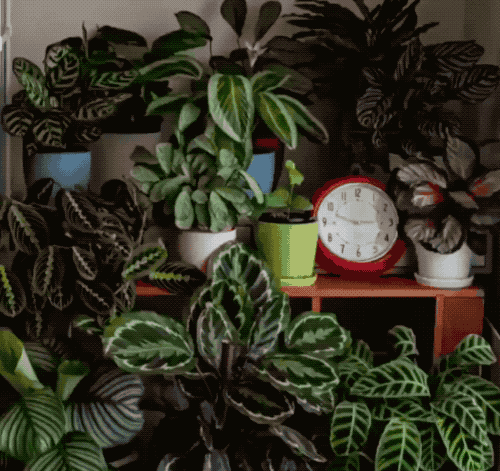#8: Friend a Fern
Meet your new homie: a houseplant.
Instructions
Find a simple plant to look at.
Each day, spend a few minutes with it.
Do a quick drawing each day. Try different techniques and materials.
After a few days, look at the drawings.
Who the Huh?
Having plants in your environment is pretty great, even if you’re not a “plantfluencer”. Within 24 hours, they move, stretch and shrink, and erase the idea of “nature” being something outside that you have to drive to.
Image: Time-lapse of plants from https://gfycat.com/pointeduniquebirdofparadise
Drawing plants is a great way to understand their structures and cycles, and perhaps to see our connection to “nature”—or rather—to remove the distinction between the internal and external.
The artist Frederick Franck led workshops around the world where people simply sat quietly and looked at plants or other “simple” things.
“Merely looking-at the world around us is immensely different from seeing it. ... Although many of us, under the ceaseless bombardment of photographic and electronic imagery that we experience daily, have lost that gift of seeing, we can learn anew, and learn to retrieve again and again the act of seeing things for the first time, each time we look-at them.
And so my workshops on seeing/drawing as meditation became retreats, retreats from all the looking-at we do. They are oases in time in which the art of seeing can be retrieved. … we draw the simplest, most commonplace things of nature, the things we have looked-at all our lives, that we may have eaten all our lives but have never really seen: a cabbage, a scallion, an apple whole and bitten into, a bowl of cherries, leaves unfolding and shriveled and dried out.
When the eye wakes up to see again, it suddenly stops taking anything for granted… The split is healed. When I am drawing a leaf or caterpillar or human face, it is at once de-thingified. I say yes to its existence. By drawing it, I dignify it, I declare it worthy of total attention, as worthy of attention as I am myself, for sheer existence is the awesome mystery and miracle we share…
Seeing/drawing is also about life, about life in its fullness, about learning to see again and thereby be totally alive and fully aware.”
– Frederick Frank, from “Zen Seeing, Zen Drawing: Meditation in Action”
Image: A leaf drawn by Franck
The idea of “dethingifying” the external world is not limited to the realm of artists. In Jenny Odell’s book “How to Do Nothing: Resisting the Attention Economy”, she shares the work of philosopher Martin Buber:
“Through attention and curiosity, we can suspend our tendency toward instrumental understanding—seeing things or people one-dimensionally as the products of their functions—and instead sit with the unfathomable fact of their existence, which opens up toward us but can never be fully grasped or known.
In his 1923 book I and Thou, the philosopher Martin Buber draws a distinction between what he calls I-It and I-Thou ways of seeing. In I-It, the other (a thing or a person) is an “it” that exists only as an instrument or means to an end, something to be appropriated by the “I”. A person who only knows I-It will never encounter anything outside himself because he does not truly “encounter”. Buber writes that such a person “only knows the feverish world out there and his feverish desire to use it … When he says You, he means: You, my ability to use it!”
In contrast to I-it, I-Thou recognizes the irreducibility and absolute equality of the other. In this configuration, I meet you “thou” in your fullness by giving you my total attention; because I neither project nor “interpret” you, the world contracts into a moment of a magical exclusivity between you and me. In I-Thou, the “thou” does not need to be a person; famously, Buber gives the example of different ways at looking at a tree, all but one of which he classifies as I-It. He can “accept it as a picture,” describing its visual elements...But there is the I-Thou option: “it can also happen, if will and grace are joined, that as I contemplate the tree I am drawn into a relation, and the tree ceases to be an It. The power of exclusiveness has seized me.”
So “join your will and grace” and go look at a houseplant.
It’ll be boring, and—eventually—fun.
Image: Will and Grace as you and a houseplant
**** The bottom part *****
Check us out on Instagram @lookandmakeart — tag this prompt with #lookandmake8
Want to share what you did? YAY! Email me with your name as you want it to appear. Archives of some or all messages will live on lookandmake.art
Have a prompt you want to share? DOUBLE YAY! Reach out!
You made it to the end. Thank you.




